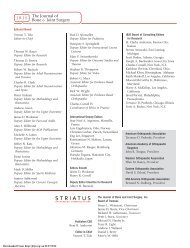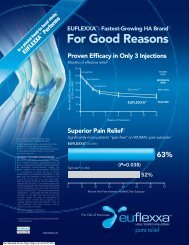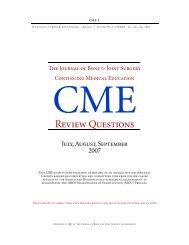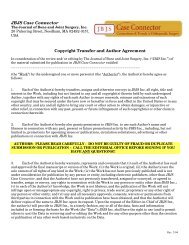Lower-Extremity Rotational Problems in Children - The Journal of ...
Lower-Extremity Rotational Problems in Children - The Journal of ...
Lower-Extremity Rotational Problems in Children - The Journal of ...
Create successful ePaper yourself
Turn your PDF publications into a flip-book with our unique Google optimized e-Paper software.
@<br />
@<br />
LOWER-EXTREMITY ROTATIONAl. PROBLEMS IN (HII.DRIN<br />
Foot-progression angle (Fig. 2-A): This angle was<br />
greatest and most variable dur<strong>in</strong>g <strong>in</strong>fancy. Dur<strong>in</strong>g childhood<br />
and adult life it showed little change. with the mean re<br />
ma<strong>in</strong><strong>in</strong>g approximately + 10 degrees and the normal range<br />
be<strong>in</strong>g between —¿ 3 and + 20 degrees.<br />
Medicil rotation <strong>of</strong> the hip (Figs. 2-B and 2-C): S<strong>in</strong>ce<br />
medial rotation was greater <strong>in</strong> female than <strong>in</strong> male subjects<br />
by a mean difference <strong>of</strong> 7 degrees. separate graphs for the<br />
sexes were constructed. Medial rotation was greatest <strong>in</strong> early<br />
childhood and then decl<strong>in</strong>ed throughout later childhood and<br />
adulthood. From the middle <strong>of</strong> childhood on. for tiiale sub<br />
jects the mean was about 50 degrees and the normal range<br />
0<br />
0<br />
0<br />
was from 25 to 65 degrees. For female subjects the mean<br />
was about 40 degrees and the normal range was froni I5 to<br />
60 degrees.<br />
Lateral Fotatioll @?tt11(' hi/) (Fig. 2—D): Unlike medial<br />
rotation, lateral rotation <strong>of</strong> the hip showed flO sex-related<br />
difference. so all values were pooled. Lateral rotation was<br />
greatest dur<strong>in</strong>g <strong>in</strong>fancy. decl<strong>in</strong>ed throughout childhood. and<br />
then rema<strong>in</strong>ed relatively constant dur<strong>in</strong>g adult IlIC. From<br />
the middle <strong>of</strong>childhood on. the mean was about 45 degrees<br />
and the normal range was from 25 to 65 degrees.<br />
Thigh-foot angle (Fig. 2-E): This angle <strong>in</strong>creased and<br />
became less variable throughout childhood. From the middle<br />
0<br />
0<br />
0 0<br />
0<br />
0<br />
0 a<br />
2 SD<br />
40°<br />
20°<br />
-20°<br />
-40°<br />
0<br />
0<br />
3 5 7 9 11 13 15-19 30s 50s 70+<br />
0<br />
0<br />
0<br />
Age (years)<br />
i)<br />
Ft(. 2-I:<br />
Thmiih—fonitatigle.<br />
0<br />
Age (years)<br />
0<br />
Fmo. 2@F<br />
Angle <strong>of</strong> the transnial leolar axis.<br />
a<br />
0<br />
0<br />
0 0<br />
0<br />
0<br />
0<br />
@<br />
@<br />
0<br />
0<br />
0<br />
0<br />
0<br />
2 SD<br />
VOL.67-A,NO. I. JANUARY1985<br />
0<br />
0<br />
.0<br />
3 5 7 9 11 13 15-19<br />
rz.<br />
0<br />
0<br />
0<br />
‘¿I<br />
2 SD<br />
0 2SD<br />
43
















